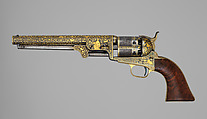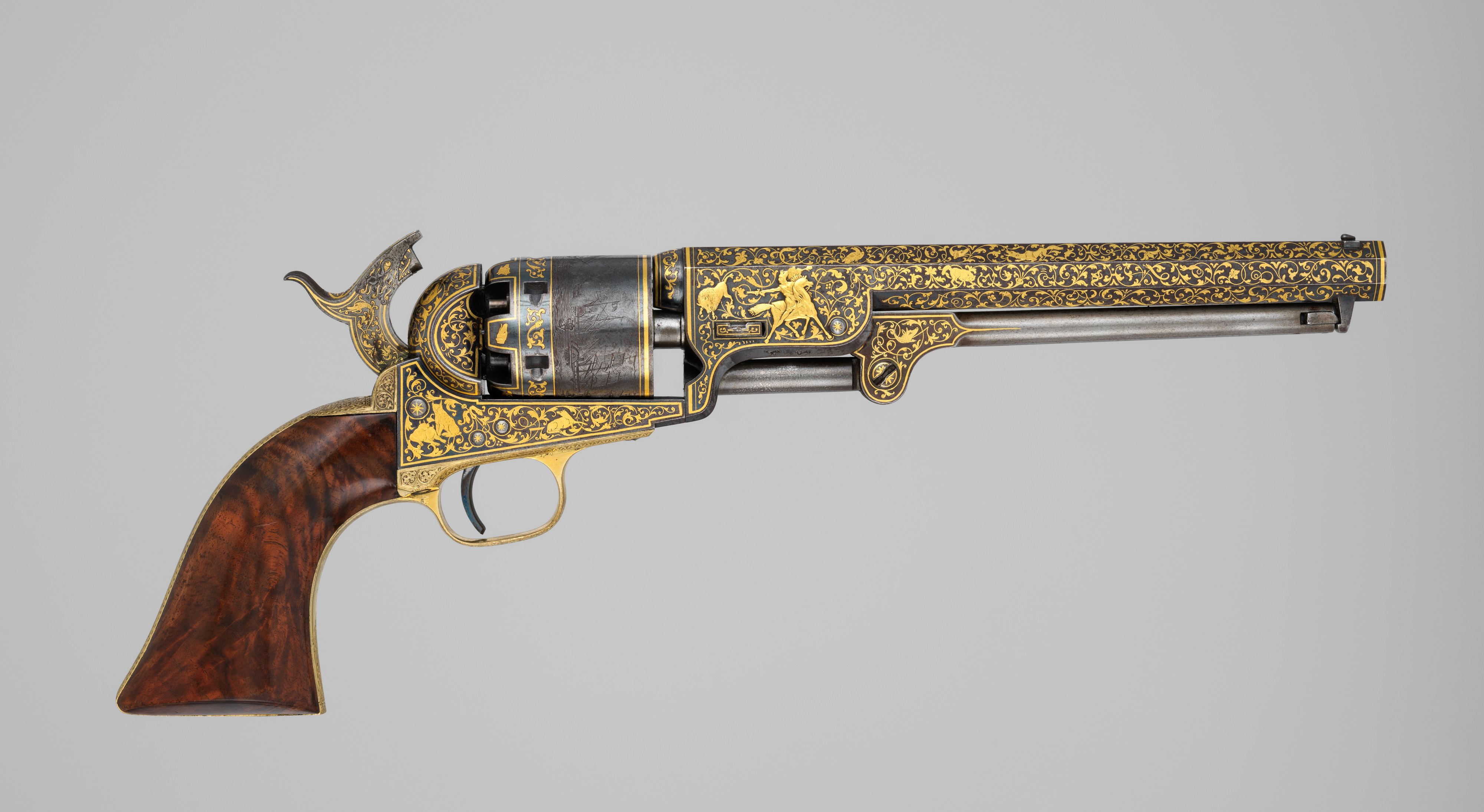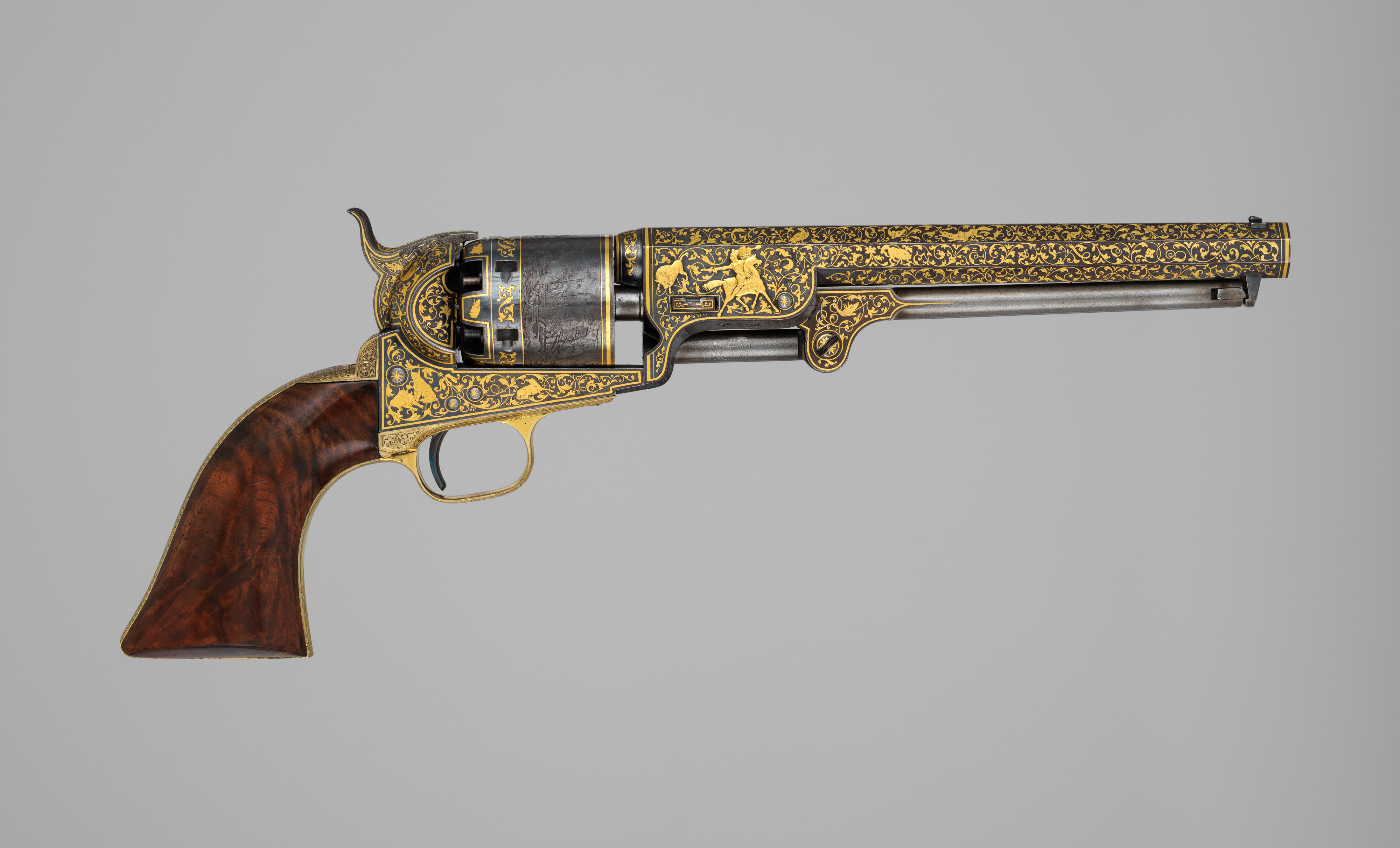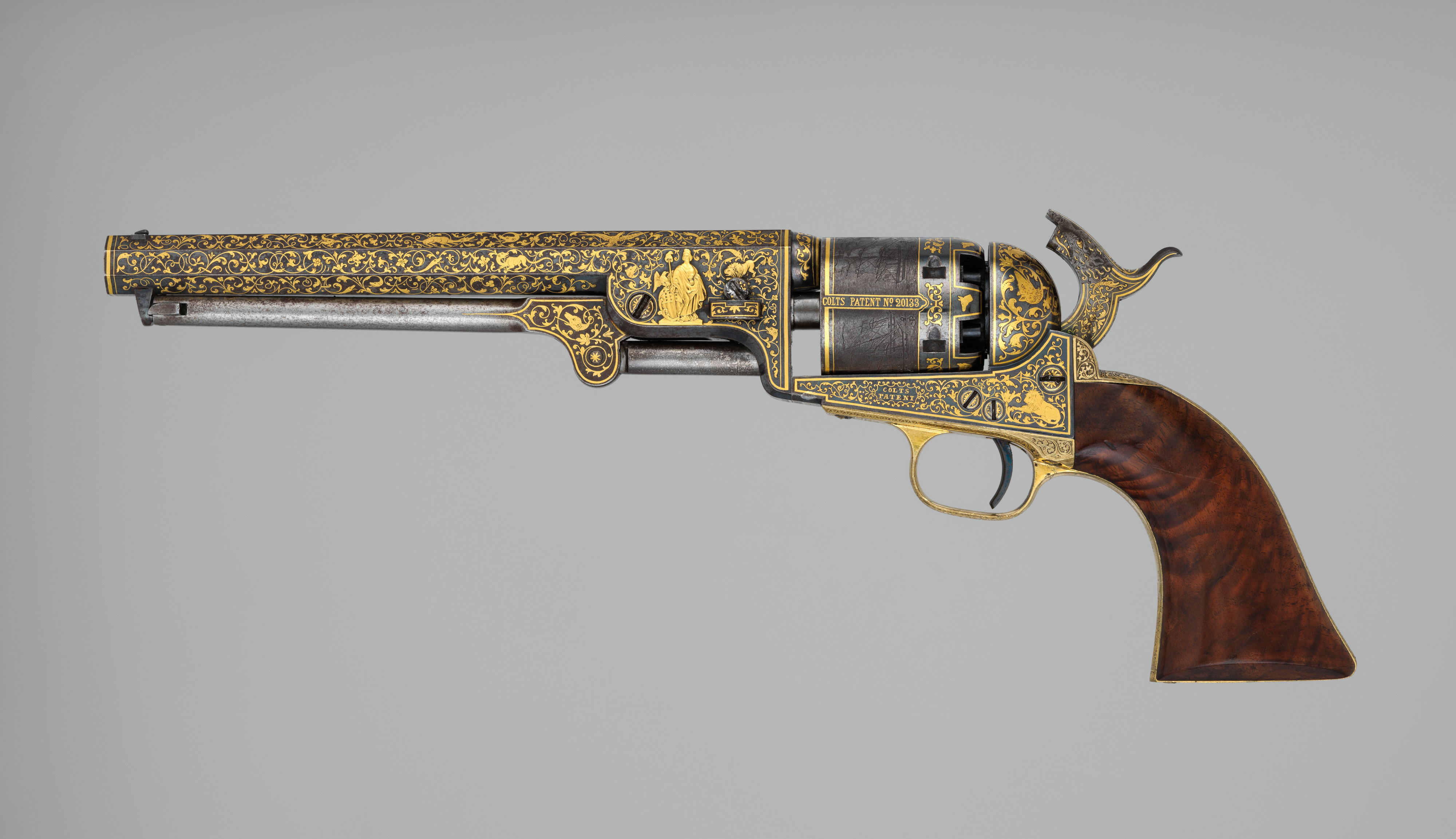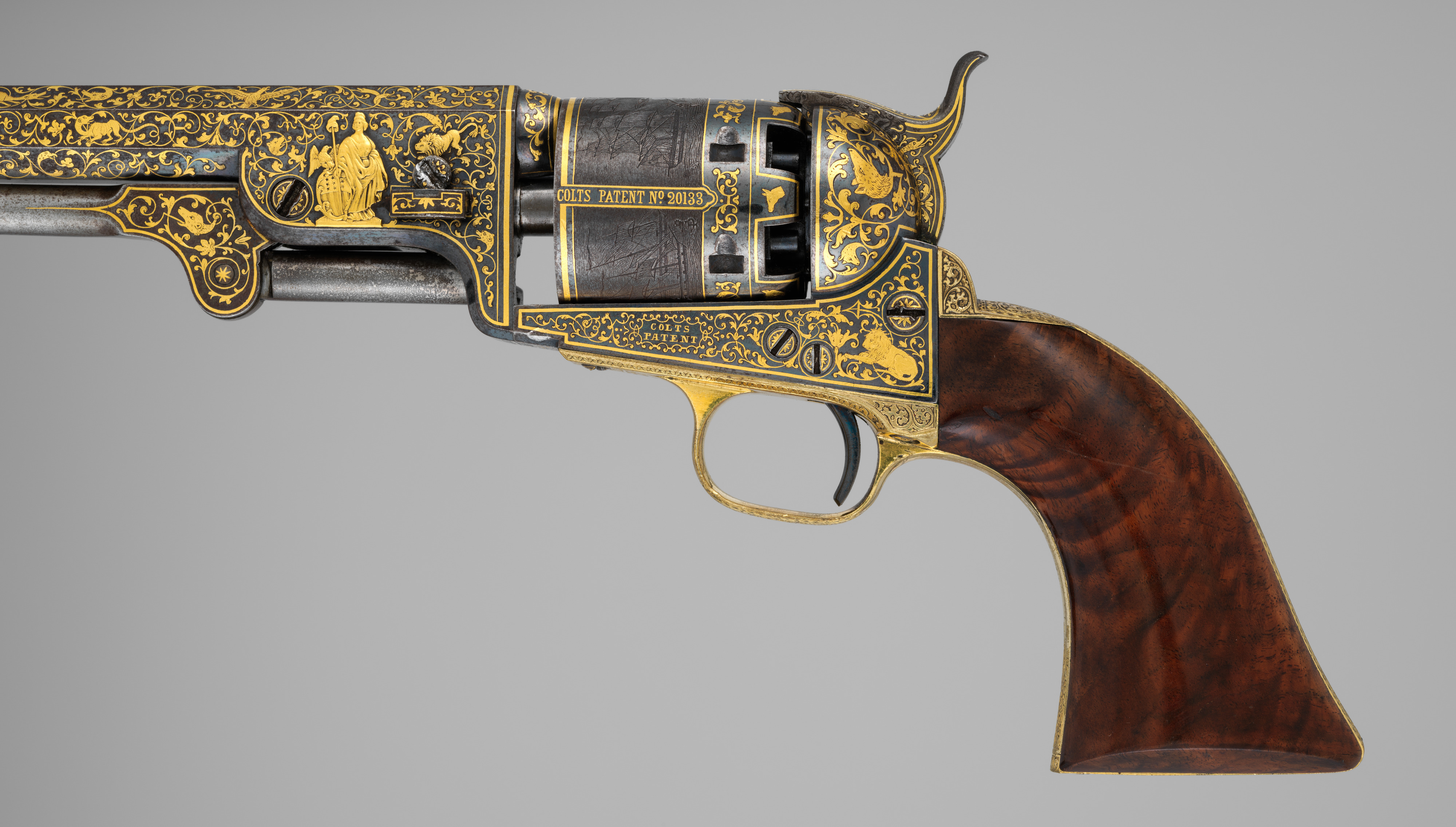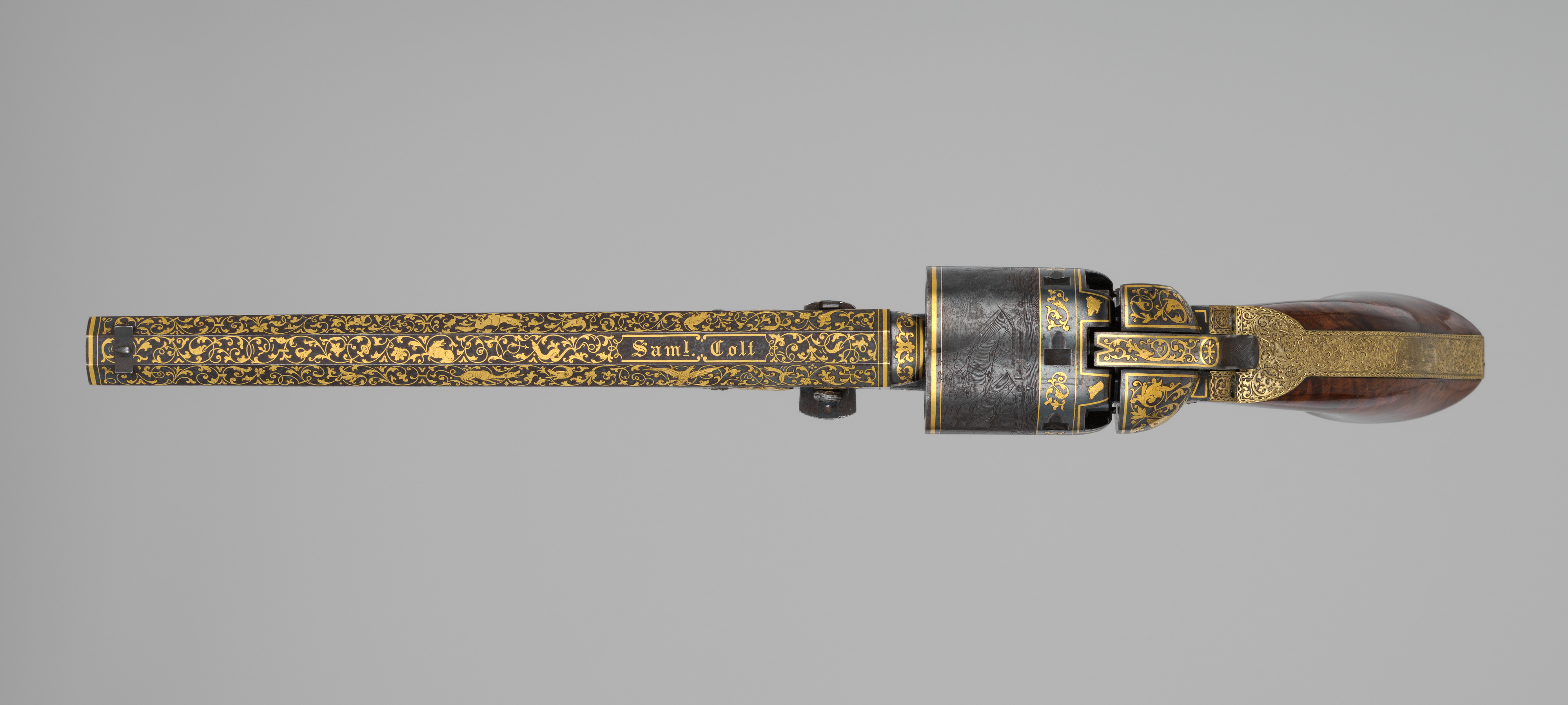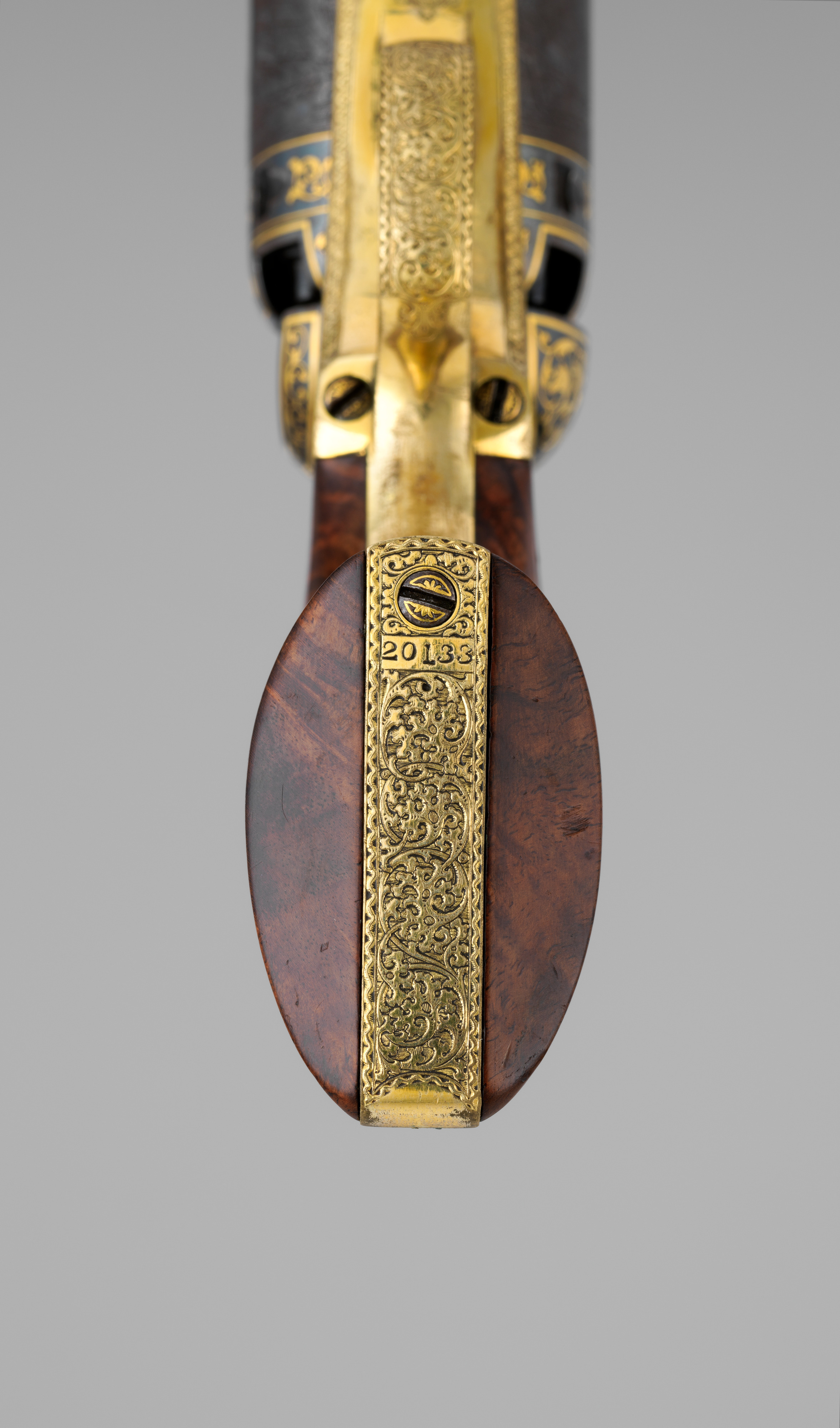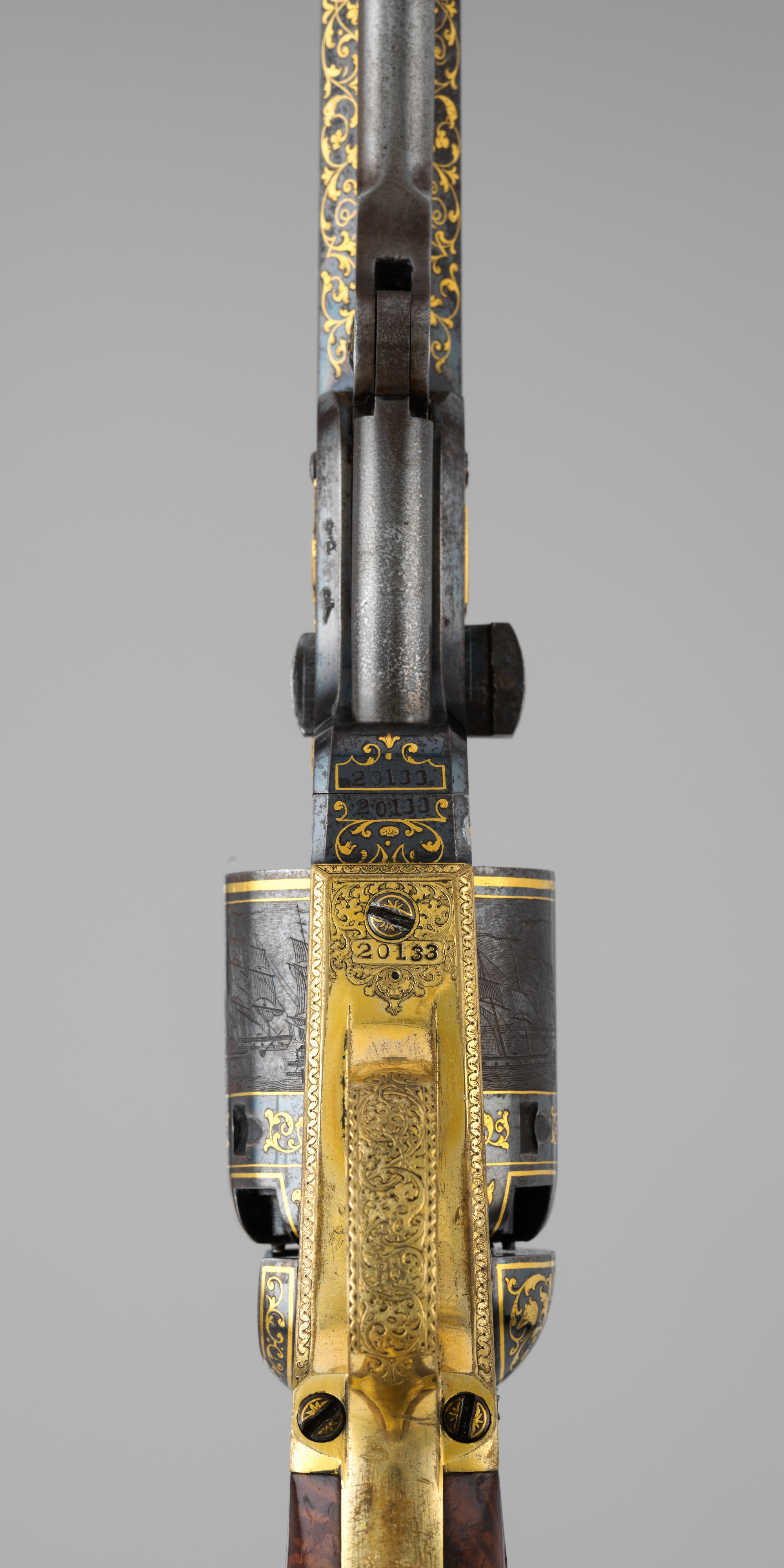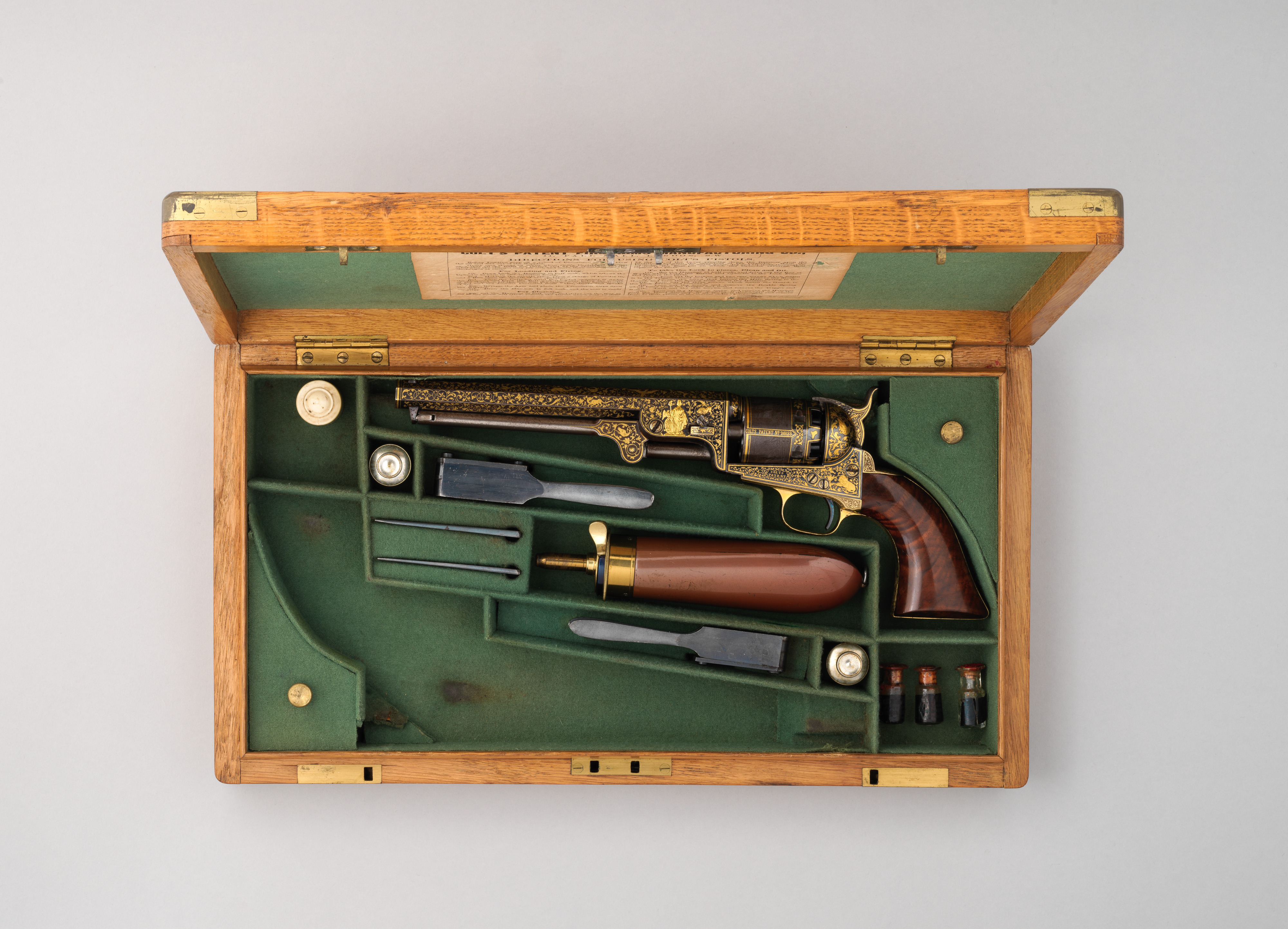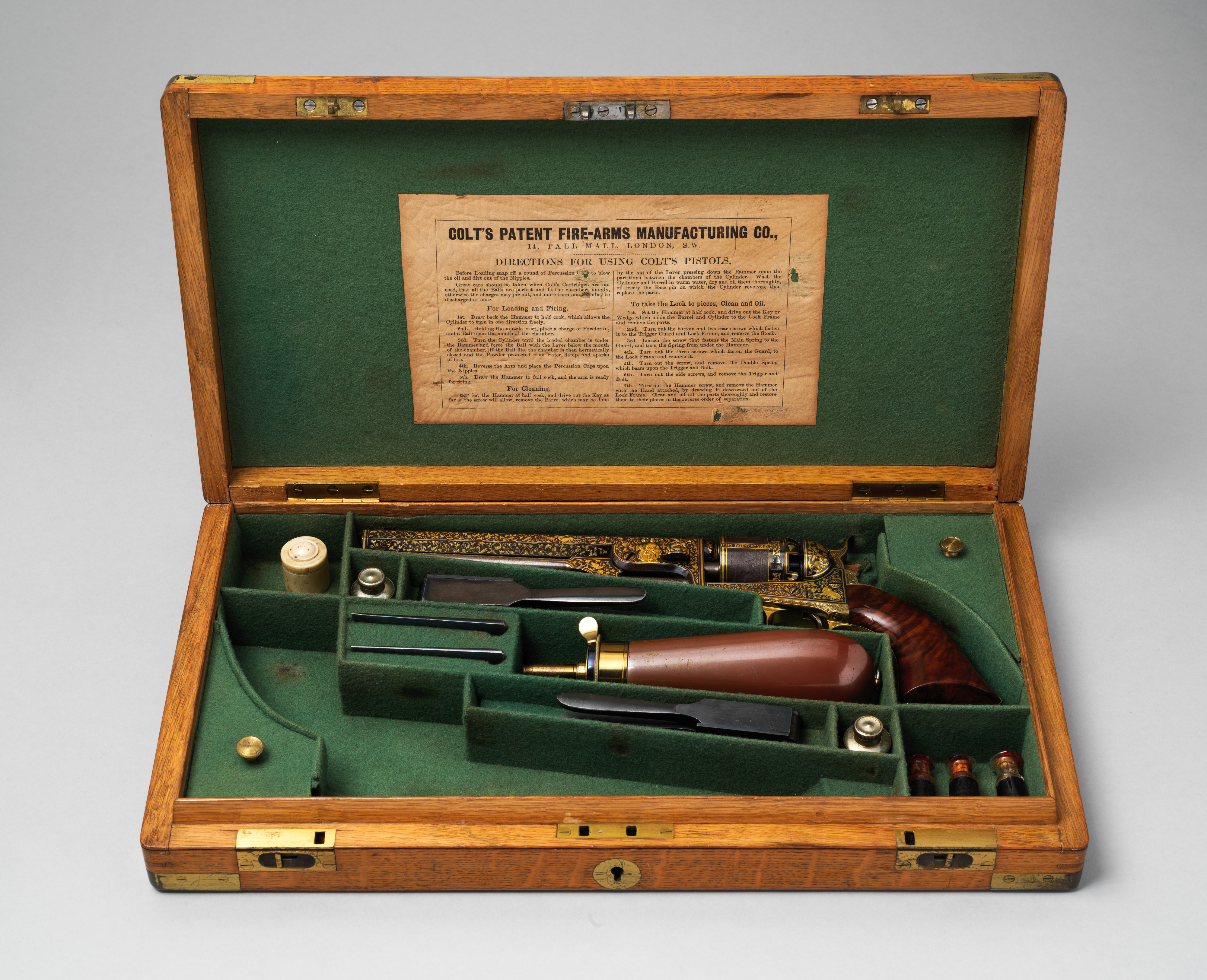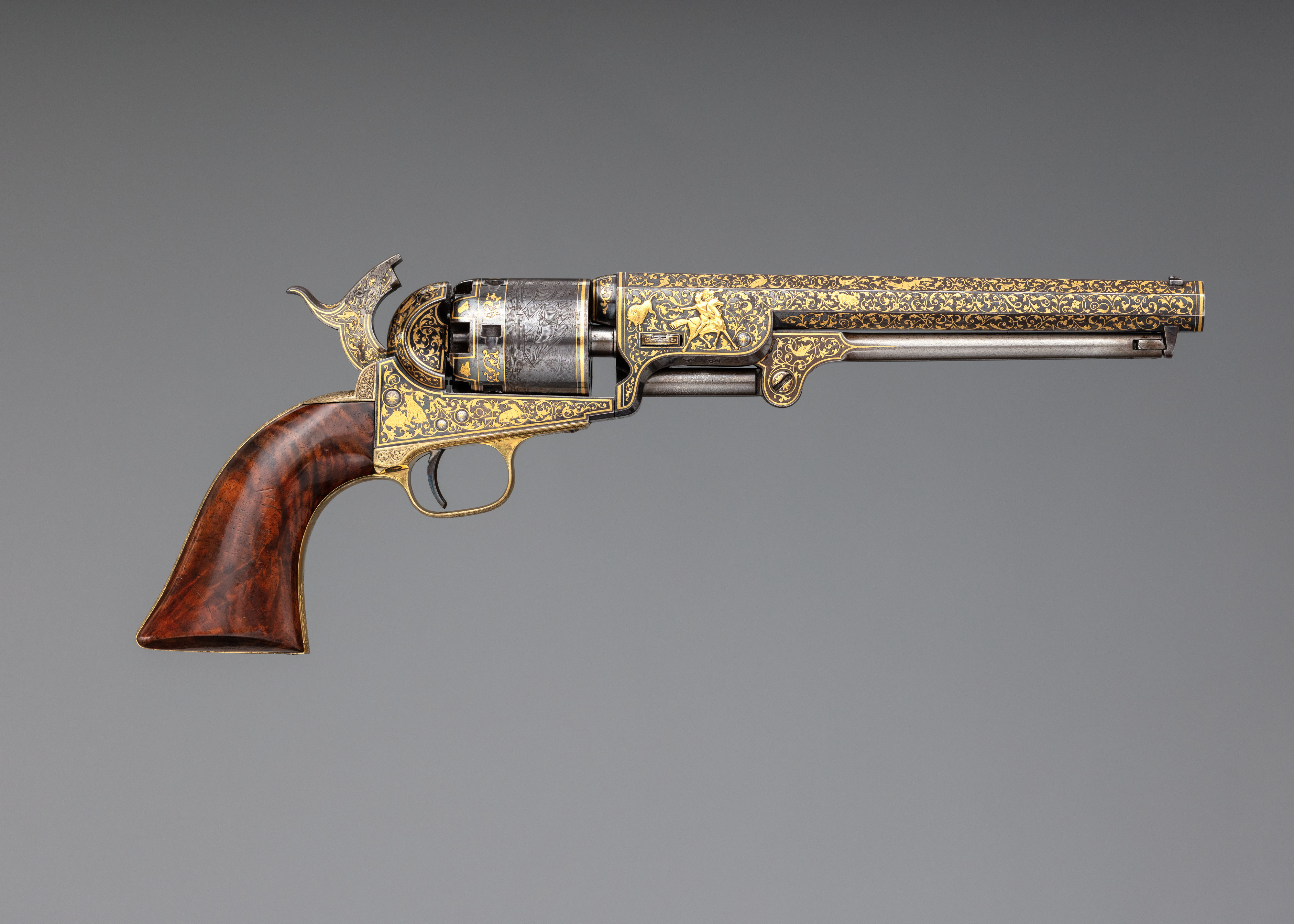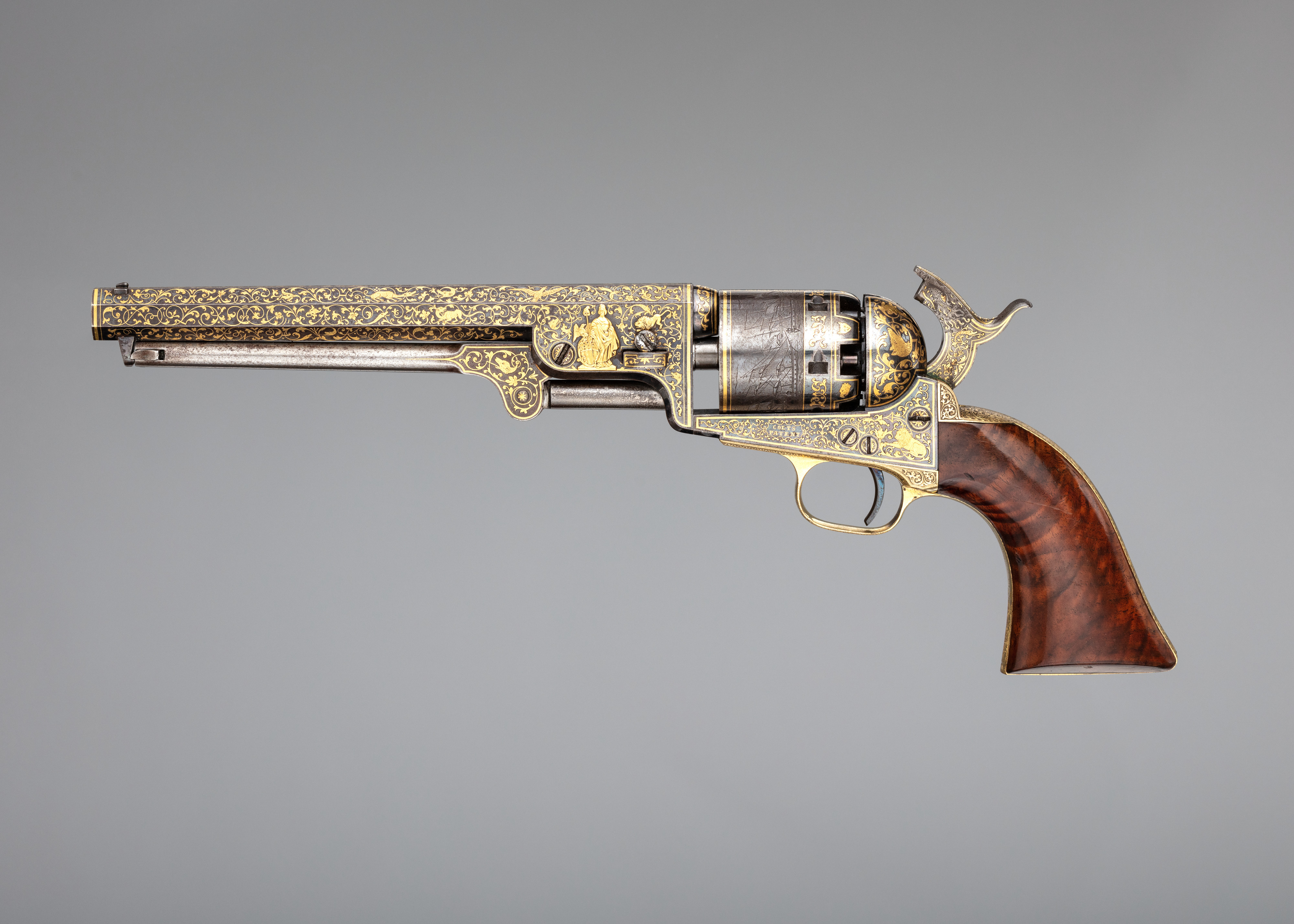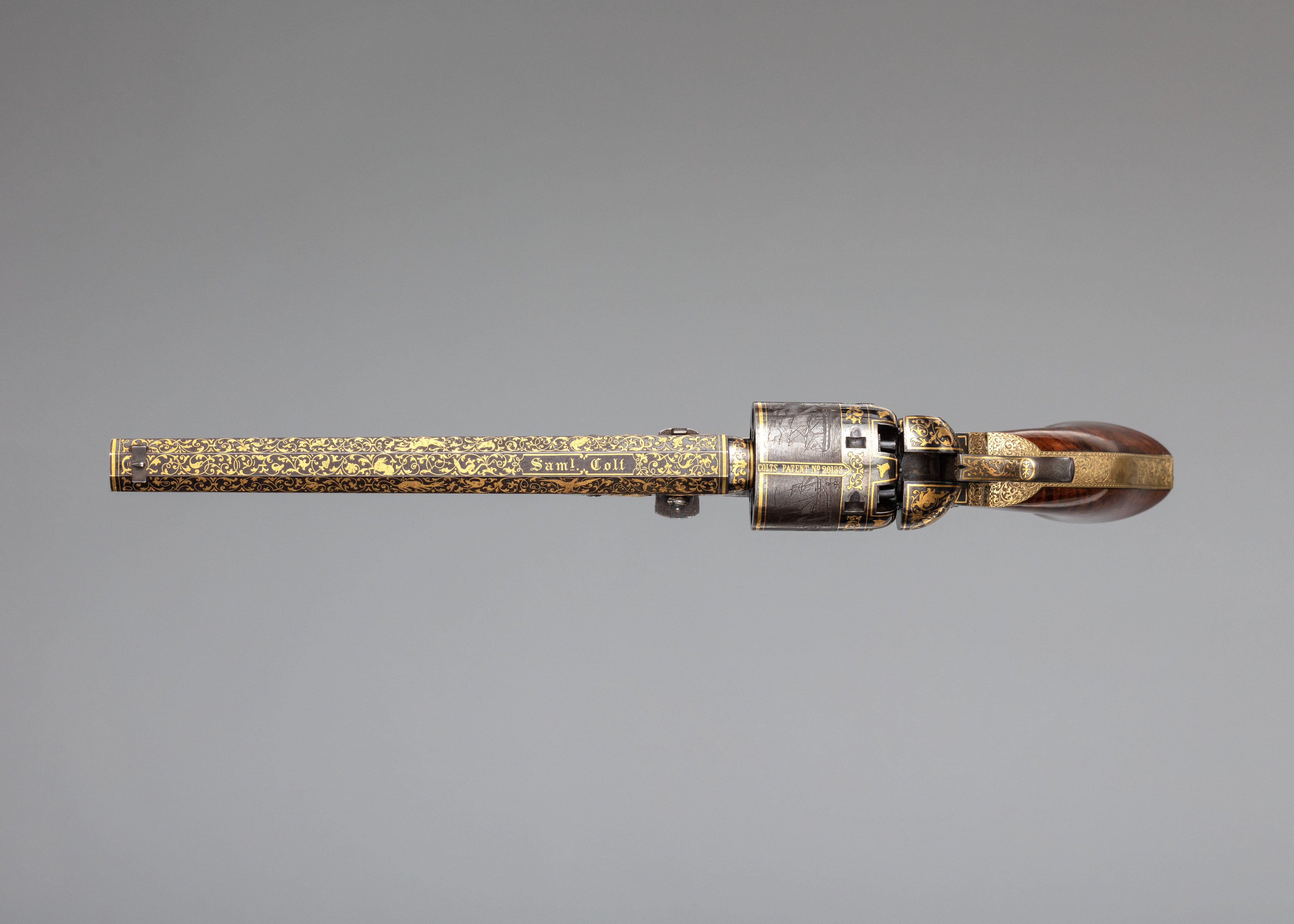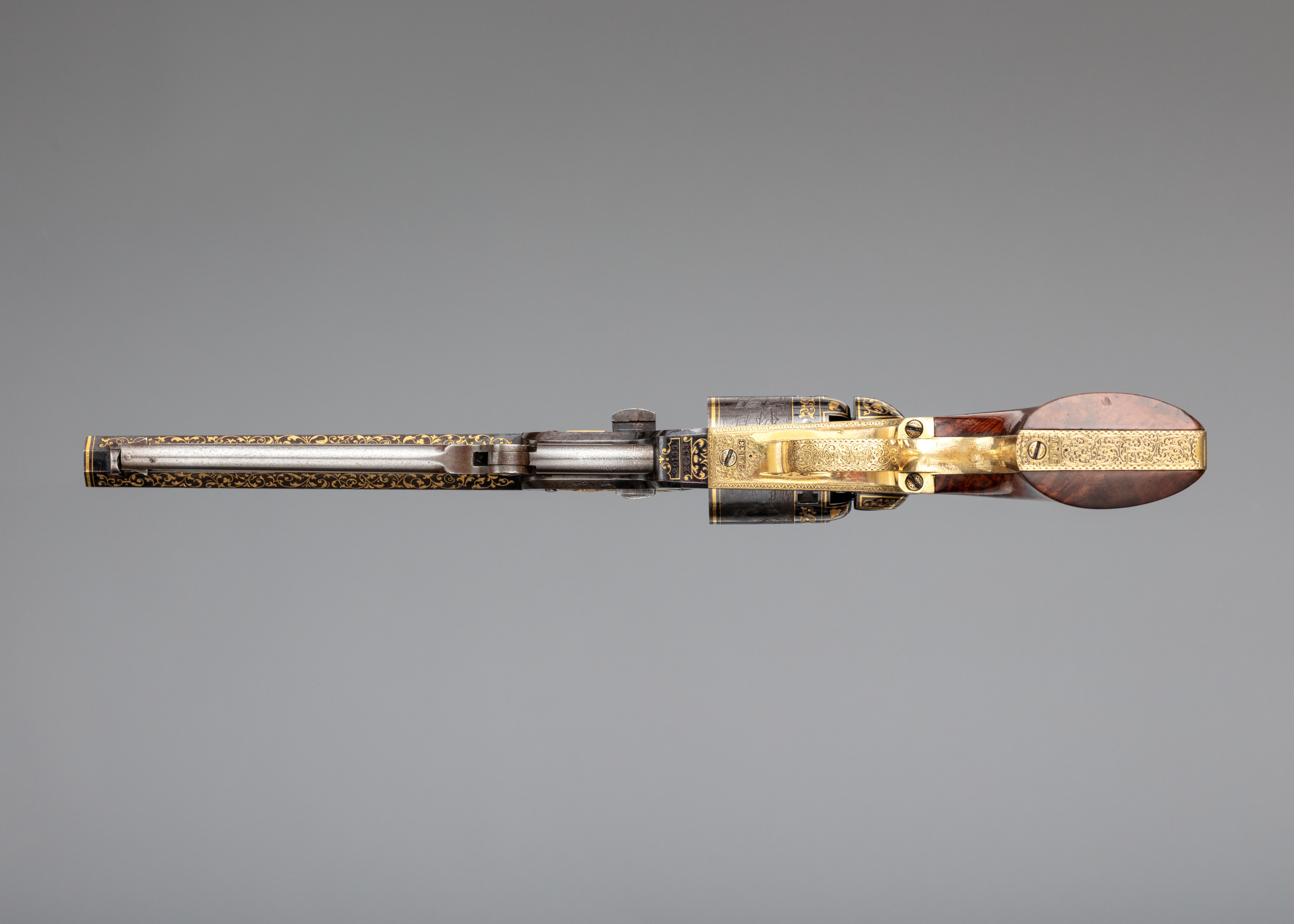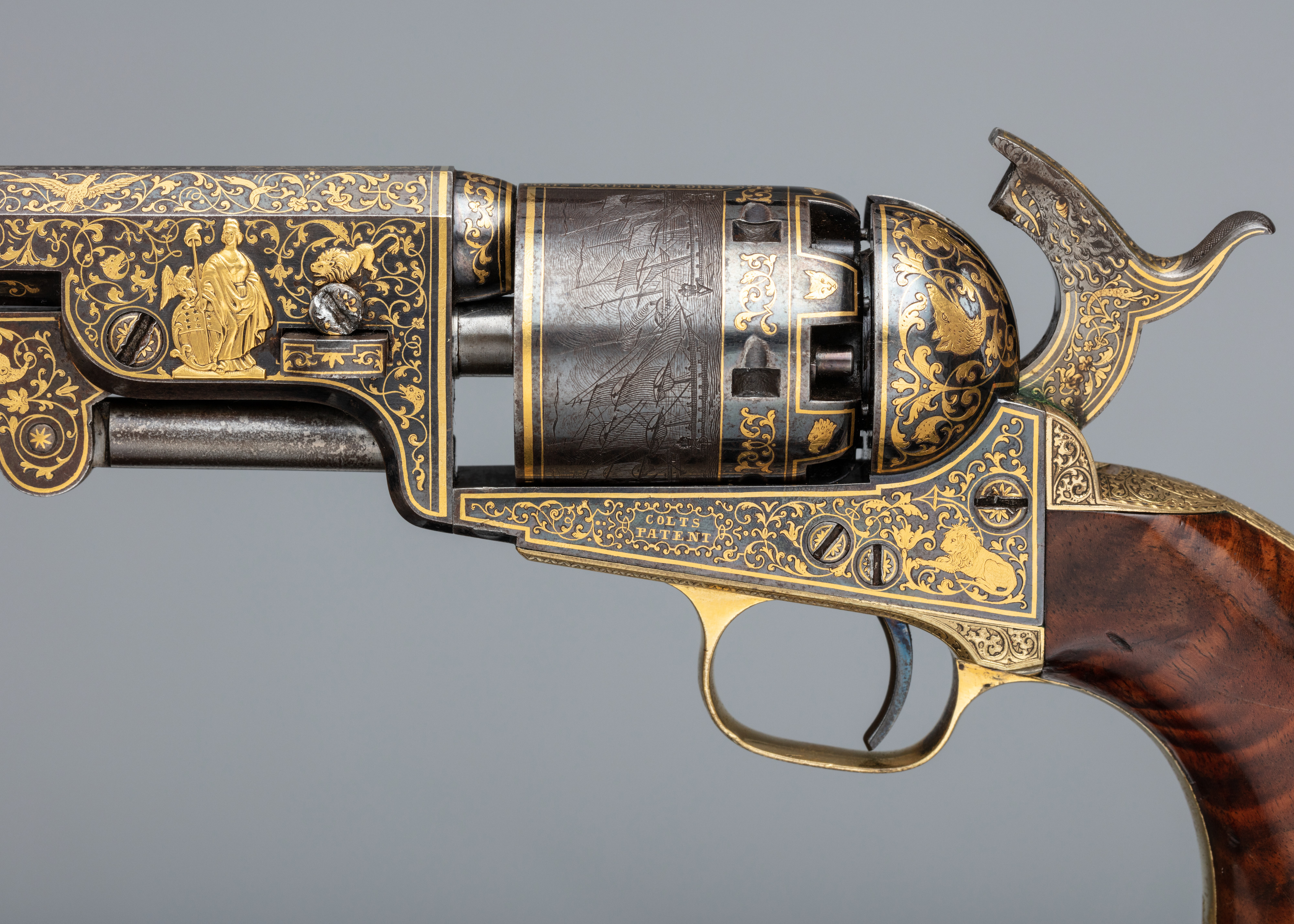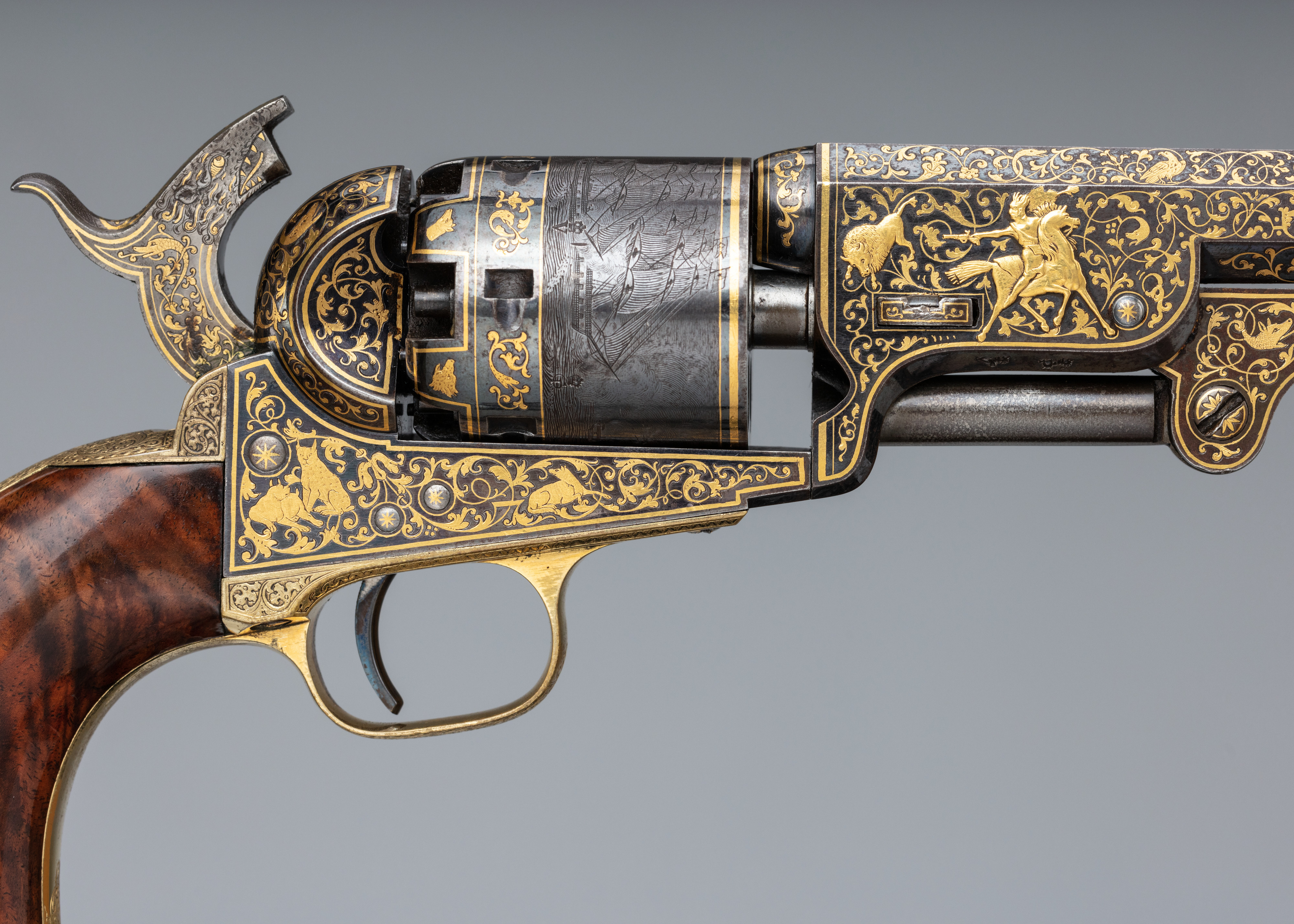Gold-inlaid Colt Model 1851 Navy Revolver (serial no. 20133), with Case and Accessories
Manufacturer Samuel Colt American
Cylinder ornament designed by Waterman Lilly Ormsby American
This Model 1851 Navy revolver belongs to a rarefied group of Colt percussion firearms decorated with profuse engraving, relief carving, and flush or low relief gold inlay, of which about twenty examples are known to survive. Made at Samuel Colt’s (1814–1862) direction for exhibition at international fairs and for presentation to important officials and foreign and domestic heads of state, including the kings of Sweden and Denmark and the czar of Russia, they functioned as diplomatic gifts and demonstrations of the company’s artistic and technical achievements.
The pistol is one of two gold-inlaid Colts donated by The Robert M. Lee Foundation to The Met in honor of the Museum’s 150th anniversary (see also acc. no. 2018.856.1). The revolvers rank among the most significant additions to the Museum’s American firearms collection in decades due to their great rarity as a type, the richness of their decoration, and their historical significance.
The American gunmaker, inventor, industrialist, and entrepreneur Samuel Colt redefined the technology and manufacture of firearms in the mid-nineteenth century, inventing innovative revolvers with interchangeable parts and elegant, durable designs. He also pioneered effective and sometimes controversial new methods of promoting his products, utilizing celebrity endorsements, seeking out armed conflicts around the world and marketing weapons to opposing sides simultaneously, and harnessing consumers’ attentiveness to aesthetics by designing his firearms to be visually appealing, giving them graceful forms and variously blued, case-hardened, and polished steel finished, sometimes inlaid and elaborately engraved.
Colt displayed his firearms to the public at international fairs, including the Great Exhibition of 1851 in London and New York’s Exhibition of the Industry of All Nations in 1853. He also made gifts of his products, usually decorated examples, to powerful individuals in positions to purchase or retail his firearms in quantity or influence their sale, and over the course of his lifetime, hundreds of pistols were given away by Colt, his company, and his family, to these ends. The small group of gold-inlaid pistols made during Colt’s lifetime, of which the Museum’s Navy pistol is one example, represent the apex of this category of exhibition and presentation Colt firearms.
The pistol’s history as an exhibition or presentation piece in the mid-nineteenth century remains unknown because, in part, like nearly all other gold-inlaid Colt pistols, the revolver does not have a dedicatory inscription. Many of Colt’s more modest presentation revolvers are inscribed with the name of the recipient on the backstrap.
Though Colt’s original use for this pistol is not recorded, the revolver has traditionally been considered the mate to a gold-decorated Navy revolver preserved in the State Hermitage Museum in St. Petersburg, one of three gold-inlaid pistols Samuel Colt presented to Czar Nicholas I at Gatchina Palace on October 30, 1854. The Metropolitan Museum pistol’s serial number (20133) follows in sequence by two digits that of the Hermitage pistol (20131), and the two revolvers are embellished in a similar style.
The other two gold-inlaid Colts presented to the Czar, also preserved in the Hermitage, comprise a Third Model Dragoon revolver (12407) and Model 1849 Pocket Pistol (63305). The mate to the Dragoon is in The Metropolitan’s collection (12406) (acc. no. 1995.336). The serial number of the Hermitage Model 1849 revolver precedes in sequence by one digit that of the gold-inlaid Model 1849 revolver in The Metropolitan’s collection (63306) (acc. no. 2018.856.1). The Metropolitan’s Model 1849 is less lavishly decorated and has a four-inch barrel compared to the Hermitage example’s six-inch barrel.
The Museum’s Model 1851 Navy pistol is one of five known gold-inlaid Model 1851 revolvers. The serial numbers and locations of the other revolvers are as follows: 14332 [Autry Museum of the American West, Los Angeles]; 20131 [State Hermitage Museum, St. Petersburg]; 23477 [private collection]; 38843 [Museum of Connecticut History, Hartford]. A sixth Model 1851 revolver (28470) sparingly decorated with gold on its cylinder is sometimes also considered part of this group [private collection].
The Metropolitan and the Hermitage’s Navy pistols are the most lavishly decorated of the group, with low-relief figural gold inlays at the barrel wedges and dense inlaid gold scrollwork interspersed with animals and whimsical creatures covering the entirety of the barrels, frames, loading lever pivots, and hammers. The figural inlays of The Metropolitan’s pistol comprise the Goddess of Liberty, a lion, and a mounted Native American firing a pistol at a buffalo. Many gold-inlaid Colts are decorated similarly with patriotic iconography, including the Museum’s Dragoon revolver, inlaid with a portrait of the first President of the United States, George Washington (1732–1799), and the Arms of the United States.
The scrollwork designs take inspiration from contemporary northern European pattern books and are reflective of the fact that many of the best firearms engravers working for Colt and other American gun manufacturers in the second half of the nineteenth century were German-born immigrants who came to the United States in the 1850s after training in Germany.
The author of the decoration on the Museum’s Navy pistol and indeed all gold-inlaid firearms made during Colt’s lifetime has remained a topic of debate among scholars for decades, with Gustave Young (1827–1895), Herman Bodenstein (1829–1865), and John Marr (1831–1921) emerging as possible candidates. Young engraved for Colt from 1853–58, Bodenstein from 1852–55 and 1856–65, and Marr from 1853–55.
The cylinder of the Model 1851 revolver (also known as a Belt Model revolver) is hand-engraved with the standard naval battle scene found on factory-decorated Model 1851 pistols of this period, though on typical Model 1851s the image is roll-engraved. The scene depicts a battle between warships of the Republic of Texas and Mexico that occurred on May 16, 1843. It was designed by Waterman Lilly Ormsby (1809–1883), an engraver with specialization in bank notes who worked for Colt since at least 1839. In addition to this naval scene, Ormsby also designed for Colt the equally iconic cavalry battle scene and stagecoach robbery scene roll-engraved on the cylinders of factory-decorated Holster Model and Pocket Pistols. The naval and cavalry designs became so well-known that the Holster and Belt revolvers became officially and popularly known as the Dragoon and Navy pistols, respectively.
The Model 1851 pistol, introduced in 1851 and remaining in production until 1873, was one of Colt’s most popular and successful percussion firearms. It was made in .36 caliber with a seven-and-a-half-inch barrel and six-shot cylinder and weighed two pounds, ten ounces. Lightweight, accurate and reliable, many considered it to be an ideal personal sidearm. It remained one of Colt’s most popular products through the Civil War, even after a New Model Belt Pistol and the .44 caliber Model 1860 Army were introduced in 1860.
This pistol is one of four gold-inlaid Colt firearms in The Metropolitan’s collection. The others include the aforementioned Third Model Dragoon revolver (12406) (acc. no. 1995.336) and Model 1849 Pocket Pistol revolver (63306) (acc. no. 2018.856.1), and a Model 1862 Police Revolver (38549) (acc. no. 2014.699) made ca. 1868, after Colt’s death. The collection also includes a pull from a Colt Dragoon frame believed to have been taken from a lost gold-inlaid revolver (acc. no. 2009.330).
Due to rights restrictions, this image cannot be enlarged, viewed at full screen, or downloaded.
This artwork is meant to be viewed from right to left. Scroll left to view more.
